Fishermen and fossils
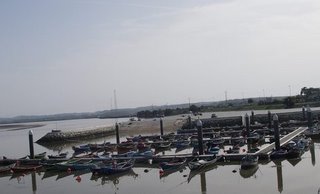 While tourism is now the most lucrative industry in Figueira da Foz fishing and the port remain an important part of the town's heritage and soul. While their story can be found in museums more physical reminders remain - the dams that used to be used to dry the salt cod (some now recycled into that most modern of industries aquaculture), the steady progression of freighters up to the docks and the rusting trawlers in the harbour.
While tourism is now the most lucrative industry in Figueira da Foz fishing and the port remain an important part of the town's heritage and soul. While their story can be found in museums more physical reminders remain - the dams that used to be used to dry the salt cod (some now recycled into that most modern of industries aquaculture), the steady progression of freighters up to the docks and the rusting trawlers in the harbour.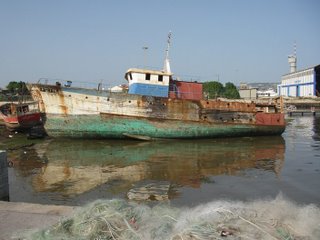 These days the fishing boats are restricted to the port in Sao Pedro, on the southern bank of the river. I can imagine that these tiny streets and the close-spaced houses became more and more of an enclave for the traditional fisherman as Figueira itself developed. As the hotels and apartments changed the look of the town fishing became less important on the northern bank, jostling for room with the restaraunts and the yacht clubs. In Sao Pedro the most important thing is not fashion and style but seasons and tides, the challenge every time they go to work is not traffic but Nature itself. This is reflected in the sunburnt and weatherbeaten faces of the people there but also in the tightness you can see as they meet and talk, they know who is "one of them" and who doesn't know the way of the sea.
These days the fishing boats are restricted to the port in Sao Pedro, on the southern bank of the river. I can imagine that these tiny streets and the close-spaced houses became more and more of an enclave for the traditional fisherman as Figueira itself developed. As the hotels and apartments changed the look of the town fishing became less important on the northern bank, jostling for room with the restaraunts and the yacht clubs. In Sao Pedro the most important thing is not fashion and style but seasons and tides, the challenge every time they go to work is not traffic but Nature itself. This is reflected in the sunburnt and weatherbeaten faces of the people there but also in the tightness you can see as they meet and talk, they know who is "one of them" and who doesn't know the way of the sea.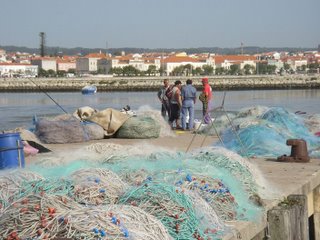 But the same wind that brings the boats home also brings the waves onto the beaches. Like the town these waves have grown with the construction of groynes and now surfing has flooded one part of the fishing port bringing surfers crashing in on the fishermans world. You might have detected a tone when I compared the beach at Figueira to Perth, well watching surfing always makes me feel like I'm at home (and that I want to jump in and catch a wave!). I love this photo - the old industry working away behind in the trawler in contrast to the new pastimes in front, but their common bond with the sea and respect for it's power seems to unite them in the water.
But the same wind that brings the boats home also brings the waves onto the beaches. Like the town these waves have grown with the construction of groynes and now surfing has flooded one part of the fishing port bringing surfers crashing in on the fishermans world. You might have detected a tone when I compared the beach at Figueira to Perth, well watching surfing always makes me feel like I'm at home (and that I want to jump in and catch a wave!). I love this photo - the old industry working away behind in the trawler in contrast to the new pastimes in front, but their common bond with the sea and respect for it's power seems to unite them in the water.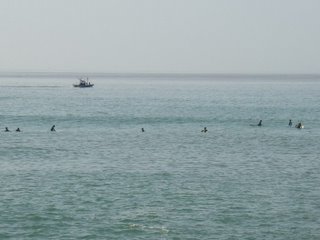 Two sisters dressed in the regional costume, photographed hanging out the car window hence the disdainful looks on their faces
Two sisters dressed in the regional costume, photographed hanging out the car window hence the disdainful looks on their faces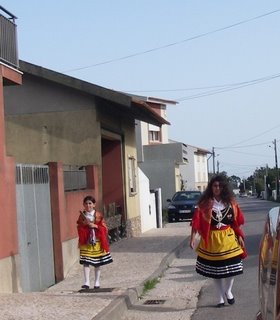
 Cape Mondego is to the north of Figueira and forms the norther barrier to the town along with the Serra da Boa Viagem (literally the Goodbye Ranges). The ranges are the garden of the town, pine woods and picnic tables providing cool green relief from the sun and sand. The Cape itself not only has an important lighthouse shown above but has a history of quarrying and coal mining. PLUS!!! the type section some bit of the Aeolian era of the Upper Middle Lower In-Between Jurassic outcrops there. I'll spare you that photo (and the embarrasing gaps in my geological knowledge!) and instead point out the way to Porto:
Cape Mondego is to the north of Figueira and forms the norther barrier to the town along with the Serra da Boa Viagem (literally the Goodbye Ranges). The ranges are the garden of the town, pine woods and picnic tables providing cool green relief from the sun and sand. The Cape itself not only has an important lighthouse shown above but has a history of quarrying and coal mining. PLUS!!! the type section some bit of the Aeolian era of the Upper Middle Lower In-Between Jurassic outcrops there. I'll spare you that photo (and the embarrasing gaps in my geological knowledge!) and instead point out the way to Porto: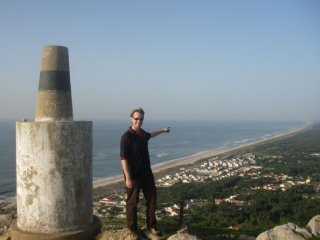

1 comment:
Billo, are you still working as a Geo or have you made the transition to travel journo!
Post a Comment